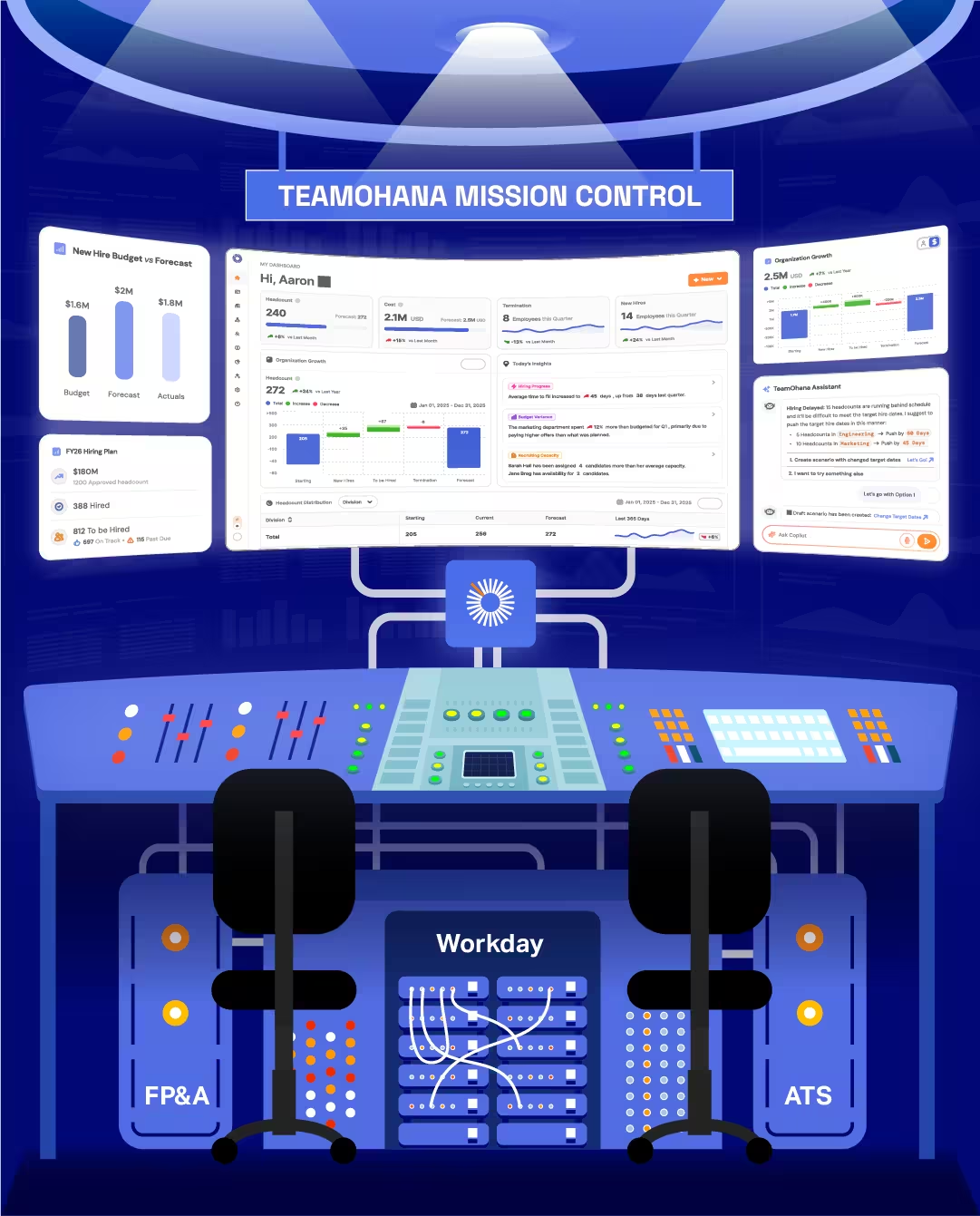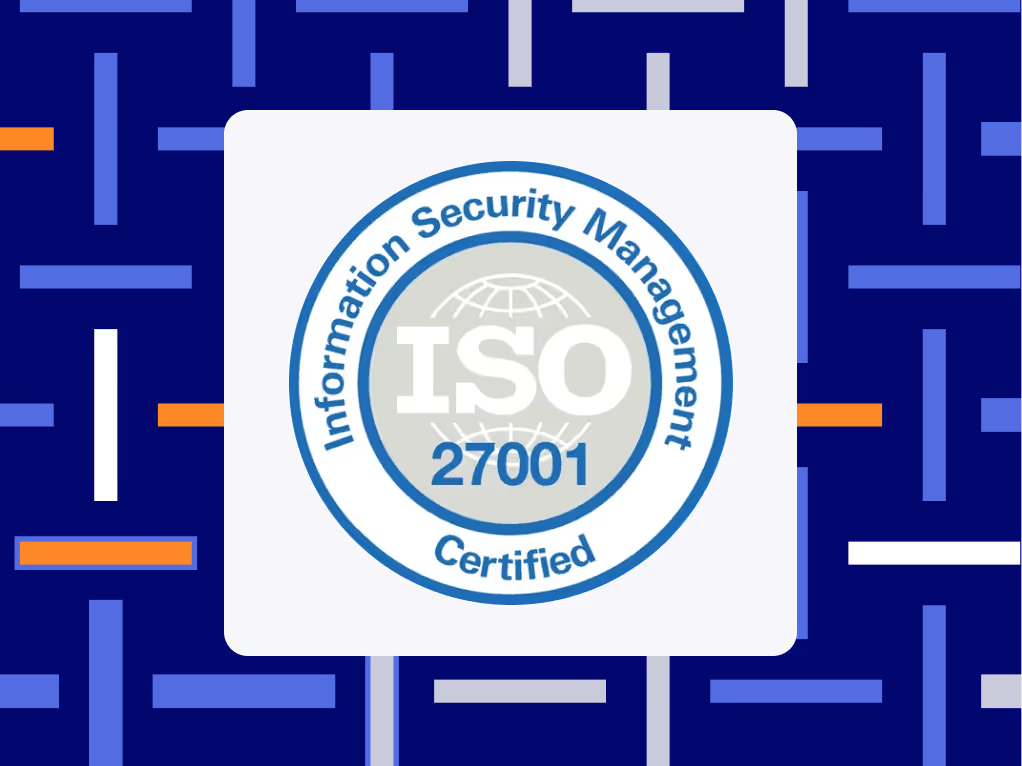Reinventing workforce management with AI

In this article
Never miss new content
A few years ago, I sat in a finance war room at a high-growth tech company. We were 300 employees strong, on track to be 1,000 in under a year. Spreadsheets were flying, offers were stalling, and no one could say with confidence how many people were actually being hired, at what cost, or whether we were still on plan.
This wasn’t a one-off. I saw the same chaos at company after company—VC-backed darlings, public SaaS leaders, and unicorns with billion-dollar caps. Everyone had a Workday or ADP and Anaplan. Everyone had Recruiters and Finance Analysts working around the clock. And still, no one could answer the most basic headcount questions: Who, when, why, and for how much are we hiring?
This is the core problem my Co-Founder, BG, and I decided to solve when we started building TeamOhana. We knew reinventing workforce management wouldn’t be easy, but we knew it had to be done.
Today’s headcount decisions demand precision, speed, and cross-functional alignment—something legacy systems can’t deliver. We built TeamOhana to meet this moment with a smarter, AI-driven approach to workforce management, and this is just the beginning.
Why headcount is so damn important
Every new hire is a long-term financial commitment, not a line item that can be easily rolled back. And unlike software spend or vendor contracts, the stakes are personal. These are the people building your product, selling your vision, and driving your growth. Hiring the right person at the right time can strengthen company culture and even boost the productivity of your existing team. On the flip side, bad hiring decisions can cause strain and erode confidence with not only your existing employees but your investors.
From an OpEx perspective, headcount is the #1 cost driver for every company with more than 50 people. It’s the essential component of workforce management that every CFO and CHRO knows they need to get right. When you over-hire, you burn cash. When you under-hire, you miss opportunities and kill growth.
Either way, the cost is real, the impacts are personal, and the margin for error is incredibly small.
Yet most companies still struggle to manage their workforce
What makes headcount and workforce management so complex is that these workflows live between departments. Finance owns the budget, HR owns the data, Talent owns the pipeline, and business leaders own the outcomes.
Historically, these groups have worked out of disconnected systems and outdated spreadsheets, turning what should be a strategic advantage into a coordination nightmare. Hiring plans drift from reality. Approvals lag, and months later, the org you thought you were building looks nothing like the one on your books.
Legacy tools weren’t built for collaboration
The problem, I realized, as I reflected on that war room experience and many others like it, is that the tools even the most elite teams had at their disposal weren’t built to support the chaotic, messy, dynamic process that is workforce management. The tools themselves were fragmented.
- Planning lived in spreadsheets.
- Approvals lived in Slack.
- Budgets lived in Anaplan.
- Requisitions lived in Workday.
- And none of these systems were talking to each other.
This fragmentation creates a massive blind spot. Finance doesn’t trust Talent, Talent doesn’t trust the HR data, and Executives are forced to make decisions based on little more than gut instinct with millions of dollars on the line.
Workday and its legacy peers like UKG, ADP, and Dayforce were built for a different world, a slower era. These platforms were designed as systems of record. They log what happened, confirm what has been approved, and show you the past.
But modern enterprises don’t run on records, they run on decisions. Modern business demands complex decisions be made lightning fast with input from multiple stakeholders. Your whole team needs to be able to assess budget tradeoffs, hiring constraints, and revenue implications in minutes, not hours or days.
This is why we believed the entire system is ripe for reinvention and it’s why we started TeamOhana.
Why now: 5 forces driving the future of workforce management
Every once in a while, the ground shifts beneath your feet. And if you’re paying attention, you don’t just adapt, you build. Right now, five powerful forces are converging to rewrite how companies manage their people.
1. Hybrid work has fundamentally changed org visibility
You can’t walk the halls to get a pulse on your team or hash out headcount decisions with hallway conversations if you work in a remote or hybrid environment, which many of us now do.
2. AI isn’t a novelty anymore
AI can now handle the operational load that’s been bogging down People and Finance teams for years. It can recommend, route, and reconcile decisions across teams and systems in a fraction of the time. And anyone who isn’t embracing this change will be left behind.
3. CFOs are raising the bar
Headcount is no longer just a number, it’s capital allocation. Every role is a bet and every hiring decision needs to be as precise as a financial investment.
4. HR is expected to do more with less
For better or worse, the expectations of HR teams have expanded, and at the same time, the margin for error has evaporated. Manual cycles, one-off spreadsheets, and disconnected systems have become a liability.
5. Legacy systems aren’t keeping up.
Workday remains a powerful system of record, but let’s be honest: it’s not where decisions happen. It’s not where collaboration happens. It’s not where the future gets built.
The world of work has changed. The software hasn’t. This is the opening and the opportunity my team and I are seizing.
The future: AI workforce management and collaborative intelligence
TeamOhana isn’t just a better interface on top of legacy systems. We knew from the beginning that if we wanted to be the workforce planning platform of the future, we needed a fundamentally different approach.
We’ve built our platform from the ground up to be modular, intelligent, and designed for real-world collaboration across HR, Finance, and Talent. It’s not a monolith or a point solution. We’re building a system of action.
Here’s what makes TeamOhana different:
- AI-native workflow engine: Our intelligent agents handle the grunt work, such as reconciling roles, surfacing variances, and flagging out-of-budget requests.
- Real-time planning + approvals: Collaborate across Finance, HR, and Talent in one user-friendly platform. Say goodbye to version control chaos. Everyone works from a shared source of truth with real-time updates.
- Built-in compensation planning + org design: Model scenarios, run merit cycles, and manage promotions—all without waiting for year-end reviews or creating separate spreadsheets.
- Integrates with Workday and your HRIS: We don’t replace your system of record. We make it useful. TeamOhana connects your tech stack, so planning sessions are more collaborative, strategic, and streamlined.
This isn’t just better UX. It’s a fundamentally different architecture built for action, not storage.
But let’s be honest, this isn’t easy
There’s a reason this hasn’t been built before.
We needed to integrate with brittle systems (yes, including the famously unfriendly Workday API). We had to figure out how to manage incredibly sensitive data, including comp, leveling, promotions, and personnel changes, and do so with strict access controls and enterprise-grade security baked in from day one.
We serve three power-users with wildly different needs: CFOs demand precision, CHROs need alignment, and VPs of Talent want speed and clarity.
We’ve had to figure out how to model complex realities such as geo-based pay bands, reorgs, and custom approval paths.
We’re building an AI-native platform custom-designed to support modern workforce planning. It’s a system, not a feature. And systems are really hard to get right.
But that’s exactly why it’s worth building.
You don’t have to reinvent your tech stack, you need an AI-powered mission control center
We’re not here to replace Workday or your HRIS, ATS, or FP&A software. We’re building the mission control center that bridges the gap between your existing tech stack and the way modern businesses actually run.
NASA’s mission control center empowers Ground Control teams to talk to astronauts in space, see live data like telemetry readings and environmental conditions, and make adjustments based on real-time conditions to ensure mission success.
TeamOhana is the mission control center that connects your systems of record, pulling real-time data from software like Workday, Greenhouse, BambooHR, UKG, etc. We empower every stakeholder, from Executives all the way down to Hiring Managers, and Recruiters to collaborate and adjust plans based on real-time conditions to ensure workforce planning success.

NASA Flight Directors need to be as close to 100% confident in every decision they make. It’s mission-critical. And we believe Business Leaders and workforce management teams deserve the same level of confidence when they’re making business-critical decisions about their most important asset: their people.
Join us on our mission to turn workforce management into a strategic lever for business growth
Our early partners, including Postman, Vercel, Scale AI, and SeatGeek, have helped us shape TeamOhana for real-world complexity and velocity. Our customers generate headcount forecasts in under two hours, reduce comp variance to under 3%, and cut headcount planning time by 80%. They move fast, and so do we.
What today is the best-in-class platform for headcount planning is quickly evolving into the control panel for compensation, org design, and real-time workforce management strategy.
Our AI Copilot is becoming a fully agentic system—one that doesn’t just answer questions, but anticipates them. TeamOhana is being built to react, reason, recommend, and execute once users select a course of action.
Kenny Tran, Head of Business Transformation at Scale AI, and one of our earliest customers, said this, “One of our credos is run through walls, so we are pushing the boundaries, and to find a partner like TeamOhana allows us to partner and push those boundaries.”
I invite you to join us on our mission to push the boundaries of what’s possible when it comes to planning and managing a workforce. If you’d like to learn more about collaborative workforce intelligence, send us a message today.

.svg)



